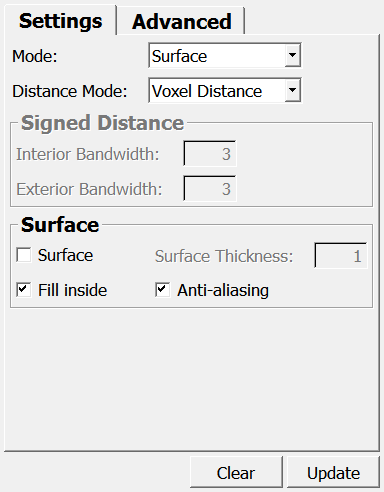VoxelizeWEM¶
- MLModule¶
author
package
dll
definition
keywords
Purpose¶
The VoxelizeWEM allows for voxelizing the surface of a WEM mesh to a given reference coordinate system defined by the input image (but only within the bounds of the input image). It supports both voxel thickness and world thickness; however, using voxel thickness is considerably faster. Additionally, it can fill the interior and provide anti-aliasing.
It utilizes the OpenVDB library.
Tips¶
If you want to voxelize the WEM to an image that has the appropriate size, you might consider using the GenerateImageForBoundingBox module, which will create an image grid of the needed size aligned to the world axes if you provide it with the bounding box values from, for example, WEMInfo module.
Windows¶
Default Panel¶

Output Fields¶
output1¶
- name: output1, type: Image¶
The index of the closest triangle.
output2¶
- name: output2, type: Image¶
The index of the closest node.
output3¶
- name: output3, type: Image¶
The closest PVL value.
output4¶
- name: output4, type: Image¶
The closest normal.
Parameter Fields¶
Field Index¶
|
|
|
|
|
|
|
|
|
|
|
|
|
|
|
|
|
|
|
|
|
|
|
Visible Fields¶
Update¶
- name: update, type: Trigger¶
When pressed, the output according to all parameters is updated.
Clear¶
- name: clear, type: Trigger¶
When pressed, the output is cleared.
Mode¶
- name: mode, type: Enum, default: Surface¶
Defines the mode in which the module operates.
Values:
Title |
Name |
Description |
|---|---|---|
Signed Distance |
SignedDistance |
The module outputs a signed distance field, using float as the output data type. The distance is positive outside a closed mesh and negative inside. |
Surface |
Surface |
The module outputs the surface and can optionally fill it and apply anti-aliasing. |
Distance Mode¶
- name: distanceMode, type: Enum, default: VoxelDistance¶
Defines whether the distance calculations use world or voxel distances.
The distance mode is utilized for
Surface Thicknessand for the output distances in SignedDistance mode.NOTE: World distances are significantly slower, as the grid needs to undergo an extra resampling step.
Values:
Title |
Name |
Description |
|---|---|---|
World Distance |
WorldDistance |
Use world distances in millimeters. |
Voxel Distance |
VoxelDistance |
Use voxel distances. |
Surface¶
- name: surface, type: Bool, default: TRUE¶
If checked, the surface is voxelized.
Surface Thickness¶
- name: surfaceThickness, type: Float, default: 1¶
Sets the thickness of the surface in voxels.
Fill Inside¶
- name: fillInside, type: Bool, default: TRUE¶
If checked, the inside of closed meshes is filled.
Anti-aliasing¶
- name: antiAliasing, type: Bool, default: TRUE¶
If checked, anti-aliasing on the borders of the surface and/or the filling is enabled.
Interior Bandwidth¶
- name: interiorBandwidth, type: Double, default: 3, minimum: 1¶
Sets the inner bandwidth in voxels when SignedDistance mode is used.
The signed distance field is propagated only this far into the interior of a surface. All other inner voxels are set to the bandwidth distance.
Exterior Bandwidth¶
- name: exteriorBandwidth, type: Double, default: 3, minimum: 1¶
Sets the outer bandwidth in voxels when SignedDistance mode is used.
The signed distance field is only propagated this far outside of a surface. All other outer voxels are set to the bandwidth distance.
Output Closest Triangle¶
Output closest PVL¶
Interpolate PVL¶
- name: interpolatePVL, type: Bool, default: FALSE¶
If checked, per-node PVL values are interpolated using the barycentric coordinates of the triangle. Otherwise, the closest point’s PVL value is used without interpolation.
Invalid PVL value¶
- name: invalidPVLValue, type: Double, default: 0¶
Sets the value that is written where no PVL value is available.
PVL name¶
- name: pvlName, type: String, default: LUT¶
Sets the name of the PVL that is used. The module supports per-face and per-node PVLs.
Invert Normals¶
- name: invertNormals, type: Bool, default: FALSE¶
If checked, the normals of the normal output image are inverted.
Output Closest Node¶
Output Closest Normal¶
Normal Mode¶
- name: normalMode, type: Enum, default: FaceNormal¶
Defines which normals are used.
Values:
Title |
Name |
Description |
|---|---|---|
Face Normal |
FaceNormal |
The closest face’s normal. |
Node Normal |
NodeNormal |
The normal of the closest node. |
Interpolated Node Normal |
InterpolatedNodeNormal |
The interpolated normal of the closest face’s node normals (renormalized). |
Normal Type¶
- name: normalType, type: Enum, default: Type_UInt8¶
Defines the data type of the normal output image.
Values:
Title |
Name |
Description |
|---|---|---|
UInt8 |
Type_UInt8 |
Uint8 in three color channels, in the range of 0-255 (centered around 128). This format can be used for the |
Double |
Type_Double |
Double values ranging from -1 to 1 in three color channels. |
Vector3 |
Type_Vector3 |
Vector3 is used for the normals. |